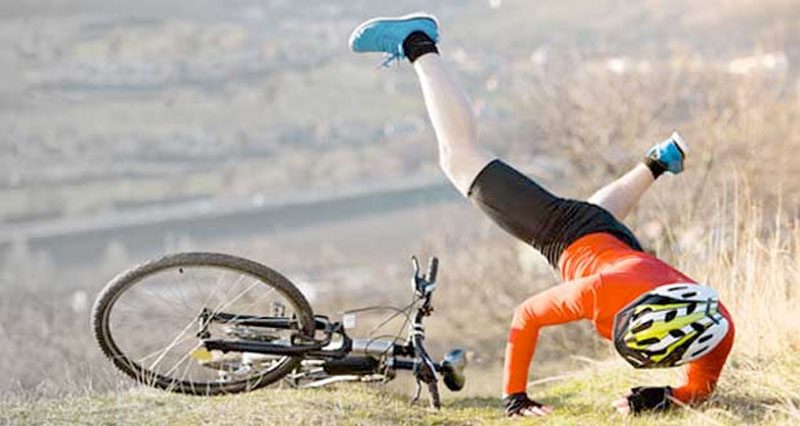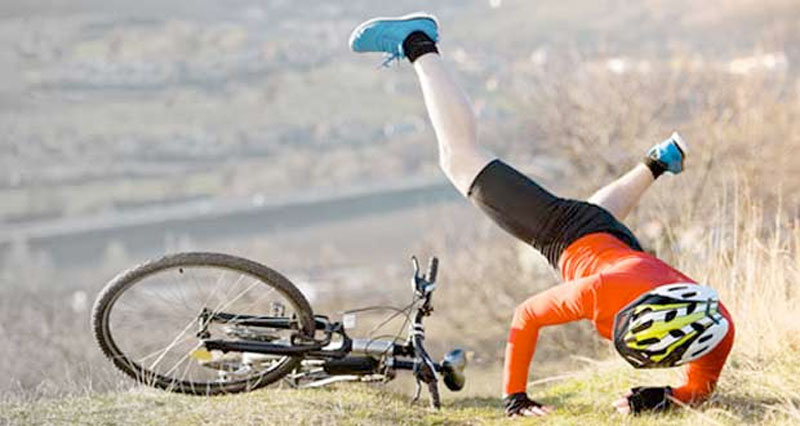Cycling injuries are either overuse injuries which develop gradually over time because of repeated movement patterns or pressures, or acute, traumatic injuries due to a fall!
Most common cycling injuries
The most common gradual-onset cycling injuries tend to be knee injuries. But wrist and elbow pain can also occur.
IT band syndrome
IT band syndrome or runners knee as it is sometimes called is a gradual onset injury causing pain on the outside of the knee. Over time the pain gets progressively worse until the player must stop. Typically they will rest for a period of time until symptoms go only for them to return again as soon as they go back to playing tennis or running. Treatment is based around reducing the pain and inflammation along with stretching, foam roller use and strengthening exercises. Read more about IT band syndrome treatment.
Patellofemoral Pain Syndrome
Patellofemoral pain syndrome (PFPS) also known as runner’s knee, chondromalacia patella is a generic term used to describe kneecap pain at the front of the knee. Symptoms include an aching pain in the knee joint, particularly at the front of the knee around and under the patella. Treatment includes rest, applying ice or cold therapy to reduce pain and inflammation along with a full rehabilitation program of specific exercises along with knee taping. Read more on treatment for patella pain.
Lower back pain
Back pain can be acute (sudden onset back pain) or chronic back pain (gradual onset or persistent). It can be difficult to diagnose due to the complexity and the number of structures and tissues in the lower back that can cause pain. Pain radiating down the leg is known as Sciatica.
Handlebar palsy
Handlebar palsy is a condition caused by compression of the ulnar nerve at the wrist against the handlebar. Symptoms include numbness, tingling, and weakness over the outside of the hand, little finger and outer half of the ring finger. Read more on the causes and treatment for handlebar palsy.
Wrist Strain
A wrist strain is a general term used to describe pain in the wrist. This may be due to a sudden force causing an acute injury, or due to overuse, causing a repetitive strain injury. Symptoms of a wrist strain include pain in the wrist which may develop gradually or suddenly. There may be a specific area which feels tender to touch and swelling may develop. Pain is likely to be reproduced when moving the wrist against resistance. Read more on the treatment for wrist strain.
Sudden onset (acute) cycling injuries
Sudden onset injuries from a fall often occur to the shoulder as the cyclist falls onto an outstretched arm.
AC joint sprain
AC joint separation or AC joint sprain is an injury to the ligament that holds the acromioclavicular joint together at the top of the shoulder. It is usually caused by a fall onto an outstretched arm. A grade 1 sprain is very mild and a grade 6 injury would be very severe. Getting early treatment and support through taping is important to avoid long-term problems or shoulder deformity. The Symptoms include pain right at the end of the collarbone on the top of the shoulder. Initially, the pain may be widespread throughout the shoulder but become more localized to a bony point on the top of the shoulder later on with AC joint sprain treatment and rehabilitation.
Rotator cuff tear
A Rotator cuff strain is a tear to any of the four rotator cuff muscles in the shoulder and is common in throwing and racket sports. They are so-called because their job is to rotate the arm at the shoulder and provide a supportive cuff around the joint. Treatment consists of reducing pain and inflammation followed by a full rehabilitation program consisting of mobility, strengthening and sports-specific exercises. Read more on the causes and treatment of a rotator cuff strain.
Should I seek professional treatment?
If you have any of the following symptoms you should seek further medical assistance.
- Severe pain, especially on walking
- Severe swelling (oedema)
- Altered sensation in the foot – such as a feeling of “pins and needles” (paresthesia) or a “loss of feeling” (anaesthesia).
- Unable to complete normal daily activities after the initial 72 hours.
Further medical assistance can be sought through either your local GP or a private clinician such as a podiatrist, physiotherapist, sports therapist, osteopath or chiropractor. If you have followed the P.R.I.C.E. principles (see below) and are still unable to walk after 72 hours or still have severe pain that is not subsiding after the first 72 hours you should visit your local A&E department for further assessment.
Secondly, if you have applied for P.R.I.C.E. principles and still have weakness that lasts a long time (more than 2 weeks) or have ongoing discomfort in your foot or heel, you are highly recommended to seek advice from a specialist expert – such as a podiatrist or physiotherapist, osteopath, or chiropractor – who can provide you with advice and an appropriate and effective recovery and rehabilitation program.
Immediate first aid for acute injuries
The PRICE principles are the gold standard set for treating acute sports injuries. The acronym stands for Protection, Rest, Ice, Compression and Elevation and should be applied as early as possible and continued for at least the first 24-72 hours.
Read more on PRICE principles.

